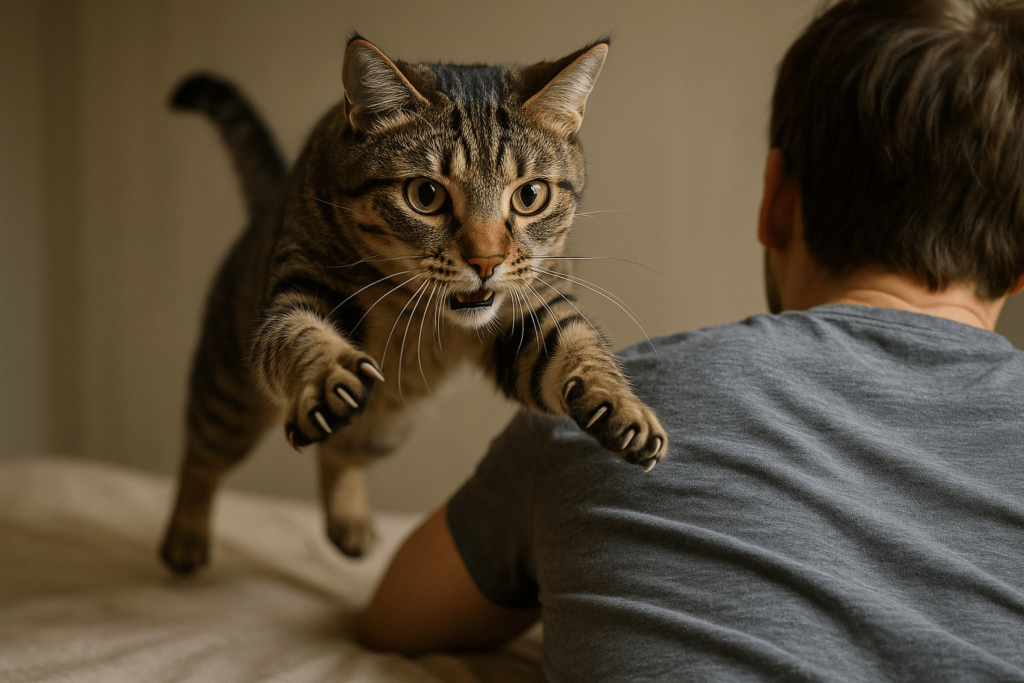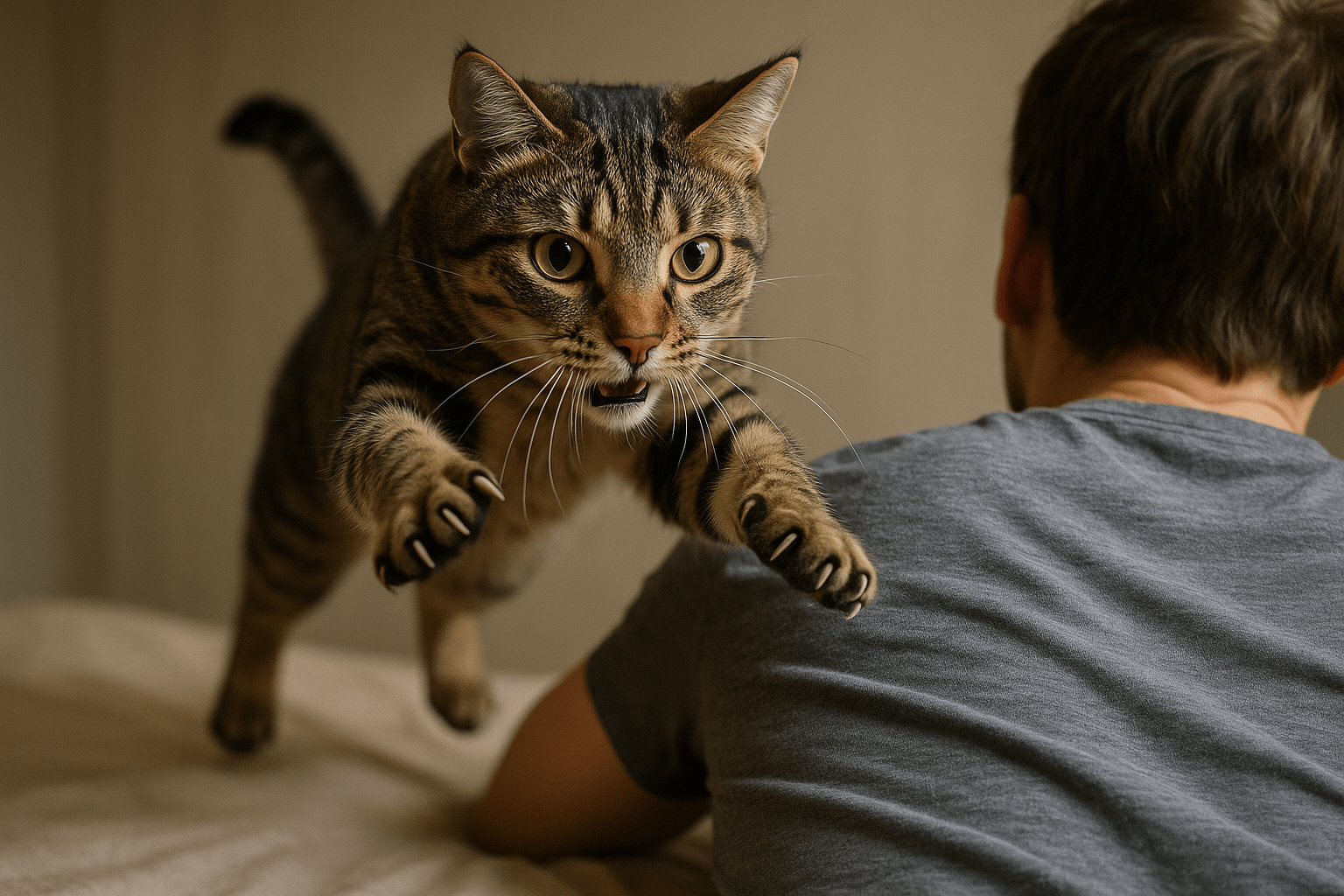Why Does My Cat Pounce on Me? Understanding Your Feline’s Playful Ambush
Cats don’t pounce on you out of aggression — they do it because it’s in their blood. That sudden leap from the shadows, the swift swipe across your ankle, the surprise tackle while you’re scrolling on the couch — it’s not personal. It’s instinct. Understanding why your cat pounces on you isn’t about stopping the behavior; it’s about channeling it. When you recognize the deep-rooted reasons behind these ambushes, you can transform frustrating moments into bonding opportunities.
This guide explores the biology, psychology, and practical solutions behind your cat’s pouncing habits — helping you build a calmer, more connected relationship with your feline companion.
The Evolutionary Instincts Behind Pouncing
Cats are predators — not pets by evolution, but by design. Their pouncing behavior is a survival trait refined over millions of years. What looks like playful mischief is actually a finely tuned hunting sequence.
Hunting Practice:
Even well-fed domestic cats retain the neurological drive to stalk, chase, and pounce — it’s how they learned to survive in the wild.Instinctual Trigger Response:
Movement — especially quick or erratic motion — activates a cat’s prey drive, making your moving foot or waving hand an irresistible target.Energy Release:
Cats sleep up to 16–20 hours a day. When awake, they need to burn off surplus energy — pouncing is their natural outlet.Territorial Awareness:
Pouncing can be a way to test boundaries or assert control over their environment, especially if they feel uncertain or overstimulated.Social Bonding Through Play:
In multi-cat households, pouncing is often part of social play. When directed at humans, it’s an extension of that same social language.
Your cat isn’t trying to hurt you — they’re practicing the skills that once kept them alive. Recognizing this transforms frustration into fascination.

The Psychological and Emotional Triggers for Pouncing
Beyond instinct, your cat’s pouncing behavior is shaped by emotion, environment, and routine. It’s rarely random — it’s a response to internal or external stimuli.
Boredom and Understimulation:
A cat left without mental or physical enrichment will create its own stimulation — often by pouncing on the nearest moving object: you.Attention-Seeking Behavior:
If pouncing has previously resulted in interaction — even scolding — your cat learns it’s an effective way to get your attention.Overstimulation or Sensory Overload:
Cats can become overwhelmed by noise, movement, or touch. A sudden pounce may be a way to reset or escape an uncomfortable situation.Play Aggression in Young Cats:
Kittens and adolescents often pounce with uncontrolled intensity because they haven’t learned bite and claw inhibition yet.Anxiety or Fear-Based Reactivity:
Some cats pounce as a defensive maneuver when they feel cornered, startled, or threatened — even if the threat is just your sudden movement.
Understanding the emotional root helps you respond with empathy, not punishment. A pouncing cat isn’t being naughty — they’re communicating.
Check this guide 👉Understanding Why Cats Swish Their Tails: Best 7 Expert Tips
Check this guide 👉Understanding Why Cats Arch Their Backs: Best 7 Expert Tips!
Check this guide 👉Why Cats Love to Lay Down: Best 7 Expert Tips!
| Biological Triggers | Environmental Triggers |
|---|---|
| Innate hunting instincts from ancestral predators | Lack of dedicated playtime or interactive toys |
| High energy levels from extended sleep cycles | Furniture or carpet textures that mimic prey movement |
| Natural reflexes triggered by sudden motion | Changes in routine or household noise levels |
| Muscle memory from kittenhood play behaviors | Inadequate scratching or climbing structures |
| Neurochemical reward from successful “capture” | Presence of other pets or visual stimuli outside windows |
How to Recognize the Difference Between Play and Aggression
Not all pouncing is the same. Learning to distinguish playful pounces from true aggression is essential for your safety and your cat’s well-being.
Playful Pounces are light, quick, and often followed by retreat. Claws are usually sheathed, and body language is bouncy, not tense.
Aggressive Pounces involve growling, flattened ears, dilated pupils, and sustained biting or scratching. These are signs of fear or overstimulation.
Redirected Aggression occurs when a cat is aroused by something they can’t reach — like a bird outside — and then pounces on you as the nearest target.
Fear-Based Attacks happen when a cat feels trapped. They may hiss before pouncing and try to escape immediately after.
Territorial Pouncing is rare but possible — especially if your cat perceives you as an intruder in their space after a change in scent or routine.
If your cat’s pounces leave bruises, draw blood, or are accompanied by vocal threats, consult a veterinarian or certified feline behaviorist. What seems like “fun” may be a cry for help.
Why Your Cat Pounces at Specific Times — And How to Use It
Cats are creatures of rhythm. Their pouncing isn’t random — it’s timed to their natural activity cycles.
Dawn and Dusk (Crepuscular Peaks):
Cats are most active during twilight hours. If you’re pounced on right before breakfast or after dinner, it’s biology — not bad manners.After Long Periods of Inactivity:
If you’ve been sitting still for hours, your cat sees you as a dormant prey item — and the sudden movement of standing up triggers their instinct.When You’re Focused on Screens:
Your stillness and lack of eye contact signal “safe target.” Your moving fingers on the phone? Perfect hunting practice.After Being Ignored or Left Alone:
Pouncing becomes a way to reassert connection. It’s their version of saying, “Hey — notice me!”During Play Sessions That End Abruptly:
If you stop playing too soon, your cat may pounce to continue the hunt. They don’t understand “game over.”
Align your playtime with your cat’s natural rhythms. Engage them for 10–15 minutes during these peak hours — and you’ll drastically reduce unwanted ambushes.
The Role of Play in Reducing Pouncing Behavior
The most effective way to stop your cat from pouncing on you is to give them something better to pounce on.
Use Wand Toys Strategically:
Mimic prey movement — dart, pause, hide. Let your cat “catch” the toy at the end to satisfy their hunting drive.Rotate Toys Weekly:
Keep toys novel. A stuffed mouse, feather teaser, or crinkle ball used only during playtime stays exciting.End Play with a Treat:
Finish each session by letting your cat “kill” the toy, then reward them with a small treat. This completes the hunting cycle.Introduce Puzzle Feeders:
Mental stimulation reduces boredom-induced pouncing. Hide kibble in treat balls or slow-feeders to engage their mind.Schedule Two Daily Play Sessions:
Even 10 minutes each, timed to dawn and dusk, can prevent 80% of unwanted pouncing. Consistency is key.
Play isn’t a luxury — it’s a necessity. A cat who plays well, pounces less.
What NOT to Do When Your Cat Pounces on You
Misguided responses can reinforce the behavior or damage your bond. Avoid these common mistakes.
Don’t Yell or Swat:
Physical punishment creates fear, not understanding. Your cat may associate you with danger — and pounce more out of anxiety.Don’t Use Your Hands as Toys:
Even gentle batting teaches your cat that hands = prey. This leads to biting and scratching during petting.Don’t Ignore All Pouncing:
Consistent reinforcement of bad behavior (even by silence) teaches your cat it’s acceptable. Redirect, don’t neglect.Don’t Confuse Pouncing with Affection:
While some cats “love-bite,” pouncing is not a cuddle. Reward gentle head-butts — not ambushes.Don’t Assume It’s Just a Phase:
Untreated play aggression in kittens often becomes ingrained in adulthood. Early correction is critical.
Patience and positive redirection are your most powerful tools. Punishment is never the answer.
Creating a Cat-Friendly Environment to Minimize Pouncing
Your home layout plays a bigger role than you think. A well-designed space reduces stress — and therefore, unwanted pouncing.
Provide Vertical Space:
Cat trees, wall shelves, and window perches give your cat a sense of security and control, reducing anxiety-driven behavior.Limit Visual Triggers:
If your cat pounces when they see birds or squirrels outside, use window films or blinds to soften the view.Offer Multiple Resting Zones:
Cats need safe retreats. Place cozy beds in quiet corners away from foot traffic.Use Scent Marking to Calm:
Feliway diffusers or catnip-infused toys can reduce stress and create a calming atmosphere.Establish Predictable Routines:
Feed, play, and sleep at consistent times. Cats thrive on structure — predictability reduces frustration.
A calm home = a calm cat. Environmental enrichment is preventative medicine.
FAQ
Why does my cat pounce on me when I’m lying down?
Your stillness signals a “safe target.” Your breathing, subtle movements, or warmth make you irresistible prey — especially if playtime hasn’t happened yet.
Is it normal for my kitten to pounce constantly?
Yes. Kittens are learning hunting skills through play. Provide plenty of interactive toys and scheduled play sessions — this behavior typically decreases by 12–18 months.
Can pouncing be a sign of illness?
Rarely, but sudden changes in behavior — like increased aggression, vocalization, or lethargy — should prompt a vet visit to rule out pain or neurological issues.
Should I get another cat to stop pouncing?
Not necessarily. While a playmate can help, it doesn’t replace structured human interaction. Two bored cats can become two pouncers.
How long until my cat stops pouncing if I change my routine?
With consistent daily play and redirection, most cats show improvement within 1–2 weeks. Full behavior change may take 4–6 weeks.
Embrace the Hunt — But Guide It Wisely
Your cat doesn’t pounce to annoy you — they do it because they’re wired to. Their instincts are ancient, their energy is real, and their need to play is as vital as breathing. You don’t have to live in fear of ankle ambushes. You don’t need to sacrifice your furniture or your peace. What you need is understanding. With the right toys, the right timing, and the right response, you can turn your cat’s wild pounces into joyful, controlled play.
You can transform your home from a battlefield into a sanctuary — where your cat thrives, and you both feel safe. The goal isn’t to stop the pounce. It’s to redirect it — with patience, with love, and with respect for the wild heart living inside your lap.
Canned Pumpkin for Cat Diarrhea: Best 7 Expert Tips! Natural remedy to firm stools, soothe upset bellies, and support gut health safely.
Can a Cat Give You Scabies? Best 7 Expert Tips! Discover the truth about feline mites, human skin risks, and how to protect yourself—without panic.
Cat Flea vs Human Flea: Best 7 Expert Tips! Discover the truth about bites, species, and how to eliminate infestations for good.
Weird Cat Behaviors: Best 7 Expert Tips! Discover why cats do strange things—and how to understand, not punish, their instincts for a happier home.





